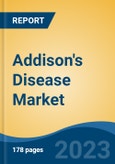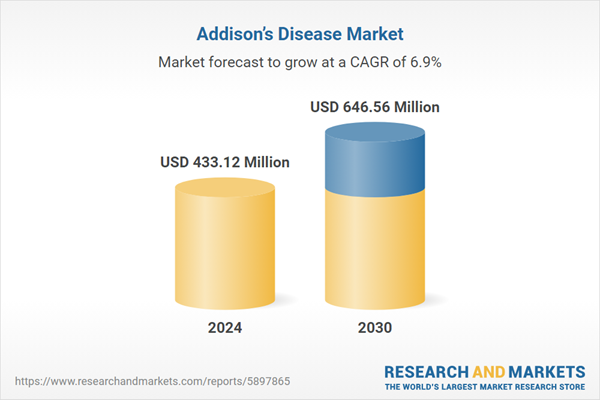Speak directly to the analyst to clarify any post sales queries you may have.
10% Free customizationThis report comes with 10% free customization, enabling you to add data that meets your specific business needs.
The rising prevalence of autoimmune disorders, which are a primary cause of Addison’s Disease, has contributed to the growing demand for effective treatment solutions. Research and development efforts focused on innovative therapies, including regenerative medicine and gene therapy, are further shaping the market landscape. Increasing investments in endocrine disorder research, coupled with pharmaceutical companies’ efforts to develop novel drug formulations, are supporting market expansion. Enhanced healthcare infrastructure and improved reimbursement policies in various countries are ensuring better access to diagnosis and treatment, further fueling market growth.
Key Market Drivers
Increasing Awareness and Early Diagnosis
Increasing awareness and early diagnosis have become pivotal in driving the growth of the global Addison's Disease market. This rare endocrine disorder, characterized by insufficient production of cortisol and aldosterone, often manifests with nonspecific symptoms such as fatigue, weakness, weight loss, and low blood pressure, making accurate diagnosis challenging. However, concerted efforts by healthcare professionals, advocacy groups, and awareness campaigns have significantly enhanced recognition of Addison's Disease among both medical practitioners and the general population. According to the National Institute of Diabetes and Digestive and Kidney Diseases (NIDDK), Addison's disease affects about 100 to 140 of every million people in developed countries.The heightened awareness has led to a greater index of suspicion among healthcare providers when evaluating patients with relevant symptoms. Consequently, individuals suspected of having adrenal insufficiency are more promptly referred for diagnostic testing, facilitating earlier diagnosis. Early detection is crucial, as it allows for the timely initiation of hormone replacement therapy, preventing potentially life-threatening adrenal crises and improving overall patient outcomes. Notably, the NIDDK reports that women are more likely than men to develop Addison's disease, with the condition occurring most often in people between the ages of 30 and 50.
Key Market Challenges
High Treatment Costs
High treatment costs are a significant barrier to progress in the global Addison's Disease market. Addison's Disease, a rare endocrine disorder characterized by insufficient cortisol and aldosterone production, requires lifelong hormone replacement therapy. While this therapy is essential for patients, the financial burden it places on individuals and healthcare systems can be overwhelming. The primary component of Addison's Disease treatment is hormone replacement therapy, primarily involving corticosteroids. These medications are effective in managing the symptoms and improving the quality of life for patients. However, the cost of these medications can be prohibitive, making access to treatment a challenge for many individuals.The high cost of Addison's Disease treatment stems from several factors. Firstly, corticosteroid medications are not inexpensive to produce, and their pricing can vary significantly between different formulations and brands. This variation in pricing can lead to disparities in care, with some patients unable to afford the specific medication that suits their needs best. Additionally, patients with Addison's Disease often require regular doctor visits and diagnostic tests to monitor their hormone levels and overall health. These appointments and tests add to the overall cost of managing the condition. Furthermore, patients may need emergency medical care in case of adrenal crises, which can incur substantial healthcare expenses.
Key Market Trends
Research and Development Efforts
Research and development (R&D) efforts have become a significant driving force behind the growth of the global Addison's Disease market. This rare endocrine disorder, characterized by inadequate production of cortisol and aldosterone, affects approximately 100 to 140 individuals per million in developed countries, with a higher prevalence among women aged 30 to 50.A key focus of R&D in Addison's Disease is the exploration of its genetic underpinnings. Researchers are diligently working to uncover the genetic factors contributing to the development of this condition. Understanding the genetic basis of Addison's Disease not only enhances comprehension of the disorder but also opens doors to more precise and personalized treatment strategies. Identifying specific genetic mutations or predispositions can lead to tailored therapeutic approaches, potentially improving outcomes for affected individuals.
In addition to genetic research, R&D efforts are concentrated on developing novel treatment modalities that go beyond traditional hormone replacement therapy. While hormone replacement remains essential, innovative therapies are being investigated to address the root causes of adrenal insufficiency. Gene therapy, for example, holds promise in correcting genetic defects responsible for Addison's Disease, potentially providing a long-term solution that reduces or eliminates the need for hormone replacement.
Key Market Players
- Teva Pharmaceuticals
- Ralington Pharma
- Aspen Pharma
- Pfizer Inc
- Merck KGA
- Anant Pharmaceuticals
- Symbiotech
- Curia
- AuroPharma
- Parchem Fine & Specialty Chemicals
Report Scope:
In this report, the Global Addison’s Disease Market has been segmented into the following categories, in addition to the industry trends which have also been detailed below:Addison’s Disease Market, By Type:
- Primary Adrenal Insufficiency
- Secondary Adrenal Insufficiency
- Tertiary Adrenal Insufficiency
Addison’s Disease Market, By Drug Class:
- Oral Corticosteroid
- Corticosteroid Injections
- Sodium Intake
Addison’s Disease Market, By Distribution Channel:
- Hospital Pharmacies
- Retail Pharmacies
- Online Pharmacies
Addison’s Disease Market, By Region:
- North America
- United States
- Canada
- Mexico
- Europe
- France
- United Kingdom
- Italy
- Germany
- Spain
- Asia-Pacific
- China
- India
- Japan
- Australia
- South Korea
- South America
- Brazil
- Argentina
- Colombia
- Middle East & Africa
- South Africa
- Saudi Arabia
- UAE
Competitive Landscape
Company Profiles: Detailed analysis of the major companies present in the Global Addison’s Disease Market.Available Customizations:
With the given market data, the publisher offers customizations according to a company's specific needs. The following customization options are available for the report.Company Information
- Detailed analysis and profiling of additional market players (up to five).
This product will be delivered within 1-3 business days.
Table of Contents
Companies Mentioned
- Teva Pharmaceuticals
- Ralington Pharma
- Aspen Pharma
- Pfizer Inc
- Merck KGA
- Anant Pharmaceuticals
- Symbiotech
- Curia
- AuroPharma
- Parchem Fine & Specialty Chemicals
Table Information
| Report Attribute | Details |
|---|---|
| No. of Pages | 187 |
| Published | April 2025 |
| Forecast Period | 2024 - 2030 |
| Estimated Market Value ( USD | $ 433.12 Million |
| Forecasted Market Value ( USD | $ 646.56 Million |
| Compound Annual Growth Rate | 6.8% |
| Regions Covered | Global |
| No. of Companies Mentioned | 10 |









